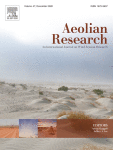Ver ítem
- xmlui.general.dspace_homeCentros Regionales y EEAsCentro Regional Buenos Aires SurEEA BalcarceArtículos científicosxmlui.ArtifactBrowser.ItemViewer.trail
- Inicio
- Centros Regionales y EEAs
- Centro Regional Buenos Aires Sur
- EEA Balcarce
- Artículos científicos
- Ver ítem
Management effects on glyphosate and AMPA concentrations in the PM10 emitted by soils of the central semi-arid region of Argentina
Resumen
In soils of semi-arid regions, different amounts of glyphosate are applied, and this substance tends to be absorbed on the topsoil exposed to erosion. The objective of this study was to analyze the effects of land management on the concentration of glyphosate and AMPA in the respirable dust emitted by soils in the central semi-arid region of Argentina. Soil samples were collected from nine agricultural soils under no-tillage with genetically modified
[ver mas...]
In soils of semi-arid regions, different amounts of glyphosate are applied, and this substance tends to be absorbed on the topsoil exposed to erosion. The objective of this study was to analyze the effects of land management on the concentration of glyphosate and AMPA in the respirable dust emitted by soils in the central semi-arid region of Argentina. Soil samples were collected from nine agricultural soils under no-tillage with genetically modified Annual crops (AG), five agricultural soils under conventional tillage with annual crops (non-glyphosate-resistant) (AFG), and two permanent grasses (PG) with no-tillage and no glyphosate application in the last 30 years. The particulate matter finer than 10 µm in diameter (PM10) was generated and collected from each soil by means of an electrostatic dust sampler. Glyphosate and AMPA were analyzed in the soils and PM10. The percentage of detection (number of samples with glyphosate/AMPA over the total number of samples analyzed) was calculated. AG had the highest glyphosate and AMPA percentage of detection, in both, soil and PM10 (100% in all cases). Similar results were found for AFG, except for glyphosate in soil, where the percentage of detection was 80%. In PG, no glyphosate was detected in soil but it was detected in 83% of the PM10 samples. AMPA was detected in 67% and 100% of soil and PM10 samples, respectively. The detection in PG suggests the entry of glyphosate and AMPA from other sites. The contents of glyphosate and AMPA in soil and PM10 were greater in AG than in AFG and PG. In soil, the content of glyphosate was 69 µg kg−1 in AG and 5 µg kg−1 in AFG. In PM10, the content of glyphosate was 224 µg kg−1 in AG, 25 µg kg−1 in AFG, and 35 µg kg−1 in PG. AMPA showed a similar behavior to glyphosate in both soil and PM10. The greater use of glyphosate in AG increases the concentration of glyphosate and AMPA in soil and PM10. It determines an increase in environmental risk when wind erosion events occur in AG. In all management systems analyzed, AMPA content was greater than glyphosate content, and glyphosate and AMPA contents in PM10 were higher than those in soil. This result shows the potential risk posed by PM10 emitted from agricultural soil to human health and the environment. To our knowledge, this is the first study that shows how land management affects the occurrence and concentration of glyphosate and AMPA in PM10.
[Cerrar]

Autor
Ramirez Haberkon, Nancy;
Aimar, Silvia Beatriz;
Aparicio, Virginia Carolina;
Buschiazzo, Daniel Eduardo;
De Geronimo, Eduardo;
Costa, Jose Luis;
Mendez, Mariano;
Fuente
Aeolian Research 49 : 100658 (2021)
Fecha
2020-12
Editorial
Elsevier
ISSN
1875-9637
Formato
pdf
Tipo de documento
artículo
Palabras Claves
Derechos de acceso
Restringido
 Excepto donde se diga explicitamente, este item se publica bajo la siguiente descripción: Creative Commons Attribution-NonCommercial-ShareAlike 2.5 Unported (CC BY-NC-SA 2.5)
Excepto donde se diga explicitamente, este item se publica bajo la siguiente descripción: Creative Commons Attribution-NonCommercial-ShareAlike 2.5 Unported (CC BY-NC-SA 2.5)

